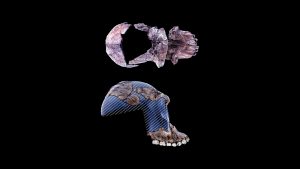
Image credit David Brill, © sciencemag.org
Australopithecus garhi (“garhi” means “surprise” in the Afar language) is a gracile australopith species (a species of Australopithecus not displaying the suite of characteristics related to strong chewing found in the robust australopiths—species in the genus Paranthropus) found in the Middle Awash of Ethiopia. Found in deposits dated to 2.5 million years ago by radioisotopic and biochronological (a technique using the relative time frames of extinct nonhominin animals) methods, Au. garhi is important because it may be the oldest hominin species to make stone tools. This possibility is discussed further below.
While Au. garhi retains many primitive features (features that are shared with its ancestors), it also exhibits derived features (features that are different from its ancestors) in the dentition (teeth). This unique morphological combination shows that a number of hominin species were likely adapting to chew tougher or harder foods at the same time, but in different ways.
Au. garhi is only known from a handful of specimens. The most important specimen is a partial cranium (skull minus lower jaw), comprising parts of the frontal and parietal bones (the bones forming the brain case, enclosing the top and sides of the brain), maxilla (the bone that comprises the majority of the face and the upper jaw), and teeth. Other postcranial (limb and torso) remains have been found in the same layers, but because they have not been found associated directly with craniodental material (material from the skull and teeth), they cannot be attributed definitively to Au. garhi. However, no other hominin species have been found in these deposits, lending support to the hypothesis that these fossils belong to Au. garhi. This postcranial material shows more human-like limb proportions. In particular, like Homo sapiens, these remains show longer femora (plural of femur, thigh bone) than Australopithecus afarensis. In H. sapiens, the ratio of shorter arms relative to our longer legs is related to bipedal locomotion. If these postcranial remains belong to Au. garhi, it would imply that Au. garhi walked bipedally and that this bipedality, based on the derived features of the postcrania, was perhaps more like H. sapiens than earlier hominins. However, the forearm to upper arm proportions are more similar to those of an ape.
The craniodental remains of Au. garhi combine traits that are similar to Au. afarensis and other older hominins and traits (especially in the teeth) that resemble those of the robust australopiths. As with Au. afarensis and other earlier hominin species, Au. garhi has a prognathic face (a face that juts forward), large canines compared to the size of its molars, and a sagittal crest (the raised line along the top of the skull where the temporalis muscle—a chewing muscle that closes the jaw—attaches). Its cranial capacity (the volume of the brain case, which approximates brain size) is estimated at 450 cubic centimeters, similar in size to other gracile australopiths (e.g., Au. afarensis). However, Au. garhi has much larger post-canine (molar and premolar) teeth than Au. afarensis; the size of these teeth is similar to species in the genus Paranthropus. This combination of features shows that the suite of characteristics related to chewing exhibited by the robust australopiths, such as the extremely large sagittal crest, flared zygomatic bone (the bone comprising the cheek), and dished face (a face with cheeks that extend forward further than the nose), do not always occur with increased size in the post-canine teeth.
The most surprising fact about Au. garhi is that it occurs in the same layers as stone tools and animal bones with cut marks. These stone tools are the earliest known flaked tools (part of the Oldowan tradition, the simplest form of stone tools) to be found in layers with hominins; the oldest stone tools, dated to 2.6 million years ago, are not found in layers with hominin remains. These stone tools are also found with animal bones showing marks made from stone tools, indicating that whichever hominins used these tools were butchering animals and eating their meat. Because no other hominins have been found in these layers, some scientists believe that Au. garhi was the maker and user of these tools; it is possible however that another hominin made and used these tools without leaving fossilized remains in these layers. If Au. garhi is responsible for these artifacts, it may be the only hominin outside the genus Homo that fashioned stone tools; such a finding would contradict the assumption prevailing among many paleoanthropologists that only species in the genus Homo had this ability. (Note: The hypothesis that early Homo species were the makers of the first stone tools was further undermined by the discovery at Dikika, Ethiopia, in 2009 of antelope and bovid bones bearing cut marks that could only have been made by stone tools. The stone tools have not been found but the cut marked bone has been dated to 3.4 million years at a site where the only hominin species was Australopithecus afarensis).
Scientists have reconstructed environments of the layers in which Au. garhi was found as the edge of a lake, probably surrounded by grassland. If Au. garhi was the first hominin to make and use stone tools, this reconstruction might provide insights into the habitats in which this important adaptation occurred.